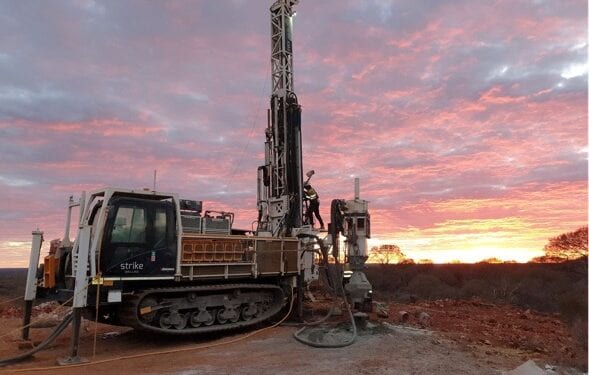St George Mining Limited (ASX: SGQ) has updated its exploration and development activities at its flagship Mt Alexander Project, located in the north-eastern Goldfields.
The DHEM survey in MAD200 has identified three off-hole EM conductors, ranging in strike length from 250m, 60m and 40m respectively.
MAD200 intersected a 12.7m intrusive unit from 500.7m downhole including approximately 1.4m of disseminated and blebby nickel-copper sulphides from 512m downhole (<5% sulphides with pentlandite (pn), chalcopyrite (cp) and pyrrhotite (py)) with laboratory assays pending.
These nickel-copper sulphides are located on the basal contact and are preserved. This is a textbook geological setting supporting the potential for further nickel-copper sulphide deposits proximal to MAD200.
The new EM anomalies identified in MAD200 are of weak to moderate conductance (<1,000s). The largest of the EM plates is located 75m to the north-west of MAD200, being the detection limit of the DHEM system, and therefore may represent a vector to stronger, more distant mineralisation.
Significantly, a number of low conductivity EM anomalies have been drilled along the Cathedrals Belt and confirmed as nickel-copper sulphides including:
- MAD201 drilled a target modelled with less than 1,000 Siemens and returned a 2.4m thick nickel- copper sulphide intercept (laboratory assays are pending)
- MAD38 drilled a target modelled with 1,300 Siemens and confirmed high-grade nickel-copper sulphides with assays of:
Ø 2.74m @ 3.77% Ni, 1.48% Cu, 0.10% Co, 3.85g/t total PGEs, 0.17g/t Au and 5.49g/t Ag from
25.4m including
Ø 0.54m @ 8.59% Ni, 3.43% Cu, 0.24% Co, 6.73g/t total PGEs, 0.14g/t Au and 10g/t Ag from 27.6m
The successful intersection of nickel-copper sulphides at these previous targets indicates that weak conductors can be a vector to high-grade sulphide mineralisation. The low conductivity reading for these and the MAD200 EM anomalies may be because the target is on the edge of the range of detectability – typically 50m to 75m around a drill hole in a DHEM survey.
The DHEM survey in MAD196, which tested 50m up-dip from MAD200, identified three very strong EM conductors that remain untested by drilling. These conductors are modelled with conductivity of 69,926 Siemens, 27,000 Siemens and 32,235 Siemens, respectively, and are interpreted to have a massive sulphide source. For further details of these conductors, see our ASX Release dated 7 April 2021 Update – Mt Alexander Nickel-Copper Sulphide Project.
The presence of multiple conductors proximal to MAD200 and MAD196 is further support for the potential of significant sulphide mineralisation in this underexplored area of West End.
SEISMIC SURVEY:
The seismic survey across the western part of the Cathedrals Belt is scheduled to commence next week. The survey is designed to map the host intrusive structures to a depth up to 2km and may also be able to identify accumulations of sulphide mineralisation within these structures.
The survey will cover the West End area and results will assist in designing further deeper drilling to test the multiple EM conductors identified in this area.
The seismic survey will also cover the area where the recent gravity survey identified numerous gravity highs. MAD202 was the first drill hole to test a gravity anomaly and successfully intersected thick intrusive-style rocks, warranting follow-up exploration. The seismic survey, as well as the completion of a DHEM survey in MAD202, will assist in the search for potential sulphide mineralisation around this hole.
See our ASX Release dated 22 June 2021 Assays Confirm High-Grade Discovery at Mt Alexander for further details of MAD202 and the seismic technique to be deployed at the Cathedrals Belt.
“Our systematic step-out drilling at the Cathedrals Belt is continuing to extend the footprint of the intrusive unit that is already known to host massive nickel-copper sulphides along a strike of more than 5.5km,” John Prineas, St George Mining’s Executive Chairman, said:
“All deeper drill holes in the western part of the Cathedrals Belt have intersected intrusive-style rocks. These results indicate a very large mineral system at the Cathedrals Belt with potential for further discoveries of high-grade mineralisation in the underexplored western section of the Belt.
“The multiple EM conductors identified at West End are particularly exciting. These are favourably located within the interpreted intrusive unit and on the same plane as mineralisation intersected by recent drill holes.
“The results of the seismic survey in this area could be very important in better understanding the distribution of mineralisation in this area and planning the next drill programme for these targets.
“We are pleased to be progressing the scoping study for the potential starter mine at Stricklands. We are trialling two new processing initiatives which may materially enhance the economics of a potential starter mine.
“We look forward to providing further updates of exploration and development activities at Mt Alexander.
“We are also excited with the drilling currently underway at our Paterson Project and will provide an exploration update on that programme shortly”.
For further information please visit: https//: stgm.com.au












